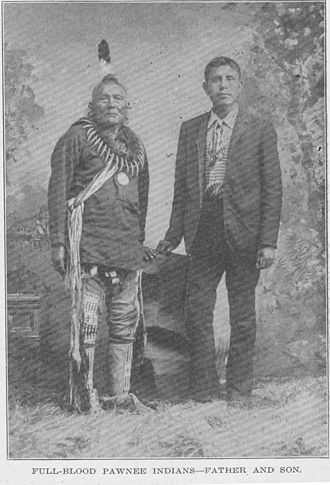Mohawk hairstyle





Mohawk hairstyle refers to a distinctive hair style in which both sides of the head are shaven, leaving a strip of noticeably longer hair in the center. This style has been associated with various cultures and movements throughout history, most notably with the indigenous Mohawk people of North America, from whom the hairstyle derives its name. However, it's important to note that the historical accuracy of this association is a subject of debate among scholars.
History and Origins[edit]
The Mohawk hairstyle is often mistakenly attributed directly to the Mohawk people, a member of the Iroquois Confederacy living mainly in areas of what is now upstate New York and parts of Canada. Historical records suggest that while the Mohawk and other Native American groups did wear their hair in various unique styles, the iconic shaved sides with a central strip may not have been widely used by the Mohawk people themselves. Instead, this hairstyle was more closely associated with the warriors of some other Native American tribes, who adopted such hairstyles for practical reasons, including the ease of wearing headgear and to intimidate their enemies.
In the 20th century, the Mohawk hairstyle was adopted by various subcultures, most notably the punk movement of the late 1970s and early 1980s. Within the punk subculture, the Mohawk was embraced as a symbol of rebellion, non-conformity, and individuality. The style was often worn in bright colors and exaggerated forms to make a bold statement.
Variations[edit]
There are several variations of the Mohawk hairstyle, including:
- Liberty Spikes: Where the hair in the center strip is styled into large, stiff spikes.
- Fauxhawk or Fohawk: A more mainstream adaptation where the hair on the sides of the head isn't completely shaven but is cut short, and the hair in the center is styled to mimic the look of a Mohawk.
- Deathhawk: Associated with the goth and deathrock subcultures, featuring backcombed or teased hair in the center strip, often dyed black.
Cultural Significance[edit]
The Mohawk has been a symbol of nonconformity and rebellion in various cultures. In the punk subculture, it represents a rejection of mainstream societal norms and a declaration of individuality. Among some Native American tribes, hairstyles similar to the Mohawk were worn by warriors or as part of specific tribal rituals, carrying significant cultural and spiritual meanings.
Contemporary Usage[edit]
Today, the Mohawk hairstyle is seen in various forms, from the extreme to the subtle, reflecting both a nod to its rebellious roots and a blend into more mainstream fashion. It continues to be a popular choice for those wishing to make a statement with their appearance, regardless of their cultural background.
Ad. Transform your life with W8MD's Budget GLP-1 injections from $75


W8MD offers a medical weight loss program to lose weight in Philadelphia. Our physician-supervised medical weight loss provides:
- Weight loss injections in NYC (generic and brand names):
- Zepbound / Mounjaro, Wegovy / Ozempic, Saxenda
- Most insurances accepted or discounted self-pay rates. We will obtain insurance prior authorizations if needed.
- Generic GLP1 weight loss injections from $75 for the starting dose.
- Also offer prescription weight loss medications including Phentermine, Qsymia, Diethylpropion, Contrave etc.
NYC weight loss doctor appointmentsNYC weight loss doctor appointments
Start your NYC weight loss journey today at our NYC medical weight loss and Philadelphia medical weight loss clinics.
- Call 718-946-5500 to lose weight in NYC or for medical weight loss in Philadelphia 215-676-2334.
- Tags:NYC medical weight loss, Philadelphia lose weight Zepbound NYC, Budget GLP1 weight loss injections, Wegovy Philadelphia, Wegovy NYC, Philadelphia medical weight loss, Brookly weight loss and Wegovy NYC
|
WikiMD's Wellness Encyclopedia |
| Let Food Be Thy Medicine Medicine Thy Food - Hippocrates |
Medical Disclaimer: WikiMD is not a substitute for professional medical advice. The information on WikiMD is provided as an information resource only, may be incorrect, outdated or misleading, and is not to be used or relied on for any diagnostic or treatment purposes. Please consult your health care provider before making any healthcare decisions or for guidance about a specific medical condition. WikiMD expressly disclaims responsibility, and shall have no liability, for any damages, loss, injury, or liability whatsoever suffered as a result of your reliance on the information contained in this site. By visiting this site you agree to the foregoing terms and conditions, which may from time to time be changed or supplemented by WikiMD. If you do not agree to the foregoing terms and conditions, you should not enter or use this site. See full disclaimer.
Credits:Most images are courtesy of Wikimedia commons, and templates, categories Wikipedia, licensed under CC BY SA or similar.
Translate this page: - East Asian
中文,
日本,
한국어,
South Asian
हिन्दी,
தமிழ்,
తెలుగు,
Urdu,
ಕನ್ನಡ,
Southeast Asian
Indonesian,
Vietnamese,
Thai,
မြန်မာဘာသာ,
বাংলা
European
español,
Deutsch,
français,
Greek,
português do Brasil,
polski,
română,
русский,
Nederlands,
norsk,
svenska,
suomi,
Italian
Middle Eastern & African
عربى,
Turkish,
Persian,
Hebrew,
Afrikaans,
isiZulu,
Kiswahili,
Other
Bulgarian,
Hungarian,
Czech,
Swedish,
മലയാളം,
मराठी,
ਪੰਜਾਬੀ,
ગુજરાતી,
Portuguese,
Ukrainian
